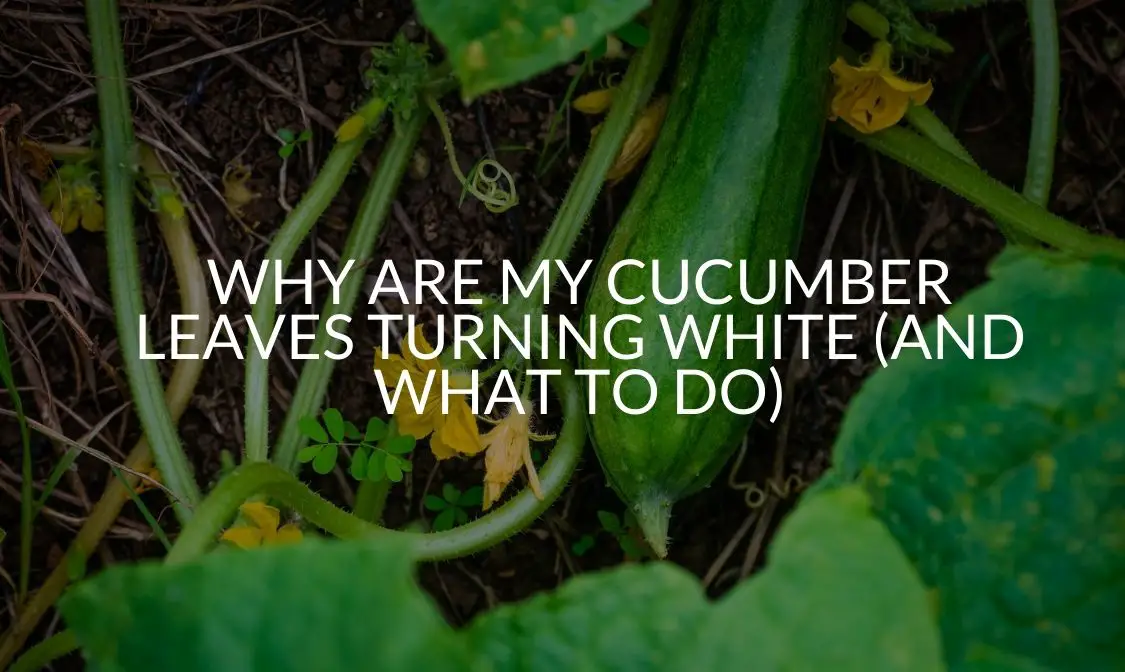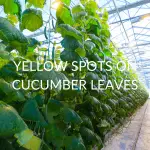Cucumbers are a favorite food for many people; they’re tender, cooling, refreshing and make a wonderful addition to any salad or sandwich. So, growing your own is great if you consume a lot of them, especially if you like to pickle. But sometimes problems arise during their development and you have to attend to them to ensure you get a good crop.
If you find yourself asking, “why are my cucumber leaves turning white,” then you more than likely have a fungal disease called powdery mildew. There are a few other pests and issues that can cause the leaves to turn white, but powdery mildew is the most common.
Why Are Your Cucumber Leaves Turning White (& What To Do About It)?
More often than not, the reason why your cucumber leaves are turning white is because of pests or diseases. To understand which one it is and take care of it, you have to look for specific signs. First, evaluate the plant and answer the following questions:
- Is it only on the leaves or is it all over the plant as well?
- Are they little white, fuzzy or powdery dots or spots?
- Did little yellow pustules form prior to the white appearing?
- Does it cover the whole leaf or only the edges?
- Do white fuzzy dots appear on the underside, upper side or both sides of the leaves?
- Does browning or curling accompany the whitish appearance?
- Do buds drop before they can form fruits?
For affirmative answers to any of the questions above, it’s one of two powdery mildew types. If you answered yes to the leaves having white spots but no to the rest, you could have a pest infestation caused by leafhoppers.
In the case none of the questions apply, then the issue could be blanching due to poor sunlight or you’re overwatering.
Powdery Mildew: Two Types
When you see leaf browning and curling as well as early bud drop, you are seeing advanced stages of powdery mildew. There are two types of fungal infections that cause the appearance of powdery mildew: Sphaerotheca fuliginea and Erysiphe cichoracearum.
This is often visible under the leaves with yellow pustules or colonies on the upper surface of the leaf. More advanced cases will have the entire leaf covered in a fuzzy white substance that can encompass the whole plant. Powdery mildew can also appear brownish.
What It Does & How It Acts
The appearance of these fuzzy white spots prevents the leaves from undergoing photosynthesis. This makes the plants grow slowly, prematurely drop buds and defoliate which results in poor-quality fruits and a low yield.
If the leaves drop, the cukes suffer from sunburn. But, if you don’t regularly remove dying foliage, it can create a moisture problem in the soil and truncate room for cucumbers to grow.
How to Fix It
As long as you treat it early, it should clear up and your cucumbers will be fine. But, if left too long to fester, the disease can adversely affect your crop. The good news is the appearance looks worse than the actual disease. Whatever you choose to use, don’t spray when temperatures are above 90°F or plants already suffering from drought.
- Commercial Fungicide: This is easy to obtain but ensure the fungicide is natural and nontoxic. However, people report mixed results because you have to keep an eye on it. So, as a general rule, as long as the infection is light and not intense, use a commercial product.
- Baking Soda: The best and most trusted thing against powdery mildew is baking soda. For more intense issues, mix one tablespoon of baking soda, one tablespoon of plant-based dish soap and about one gallon of water. Spray this until the entire plant and soil saturate with the mixture.
- Potassium Bicarbonate: As a trusted farmer’s friend for centuries, potassium bicarbonate kills powdery mildew right away. It’s organic, nontoxic and works like a dream. You can find this at most home improvement or gardening centers.
- Vinegar: The acetic acid within vinegar makes it a great option to fight powdery mildew. Mix 3 tablespoons vinegar with about one gallon of water and spray it gingerly on the plant. Ensure you don’t burn the fruits by using too much.
- Milk: Research shows that organic, raw or skim milk can kill powdery mildew. There are constituents that not only provide antibiotics but also improve immunity. Mix one part milk with nine parts water and spray over the plant and soil, especially under the leaves. Don’t use 2% or whole because the higher fat content does more harm than good.
- Neem Oil: A popular panacea for plant pests and diseases is neem oil. Hailing from India and East Africa, it’s effective against powdery mildew. You can either mix a few drops of this with water, vinegar, milk or horticulture oil. Then, spray it on the affected areas of the plant.
Leafhoppers
The one pest that gives cucumber leaves a whitish look is leafhoppers. These are wedge-like, small insects with a brown, yellow or green color. They eat the leaves, piercing them with their mouths and sucking out the fluids.
This causes little white specks or stipples on the upper surface of the leaf. Eventually, the leaves dry out, curl up and turn brown, giving a burned appearance.
How to Fix It
On the plus side, there’s nothing you have to do because they don’t cause long-term damage. Although unsightly, it shouldn’t present a problem with development, appearance or yield.
Too Much Moisture
Another thing that makes cucumber leaves appear white is excess moisture. When there’s too much, the nutrients are leaching out too quickly and this makes it hard for the leaves to maintain their color. Water, humidity, airflow and sunlight can contribute to this issue.
How to Fix It
First, ensure you’re not overwatering and only give water when the soil is dry. When there’s a lot of humidity, avoid watering even if the soil is dry. Because there’s not enough nutrients either, use a phosphorous-rich fertilizer once the soil returns to normal. Ensure plants have space so plenty of air and sun aerate the soil.
Blanching from Lack of Sunlight
If your cucumber plants aren’t getting enough sunlight, it can cause the leaves to appear whitish. This is because it lowers chlorophyll production, which in turn, inhibits proper photosynthesis. Therefore, the foliage and fruits become discolored.
How to Fix It
Ensure your plants receive an even amount of sunlight and that it hits every leaf. Trim leaves and neighboring plants to allow more access to sunshine.
Why Are Your Cucumber Leaves Turning White Around The Edges (& What To Do About It)?
When whitening around the edges of cucumber leaves occurs, it’s mostly likely powdery mildew. This is how the disease begins, by turning the leaf edges white.
How to Fix It
Create an antifungal spray for your cucumber leaves. First, in a clean spray bottle, blend about 8½ cups of water with one teaspoon of baking soda. Close and shake until well dissolved. Then add four drops of vegetable or horticulture oil, this helps the mixture stick to the leaves.
Spray this onto the leaves the moment you notice white spots. Saturate the leaves and surrounding soil once per week until the problem disappears. If the powdery mildew is a repeated problem, dig up the plant and replace the soil. If grown in a pot, find a new container and ensure you’re using sterile soil.
If planting in the ground, test the soil for contaminants. In the case it’s infested with fungus, you will have to take deliberate steps to fix it.
Why Have Your Cucumber Leaves Turned White After A Transplant?
Sometimes a white fuzzy substance appears on cucumber leaves after a transplant. There are only two causes for this: transplant shock or powdery mildew. More often than not, it’s going to be powdery mildew.
Transplant Shock or Powdery Mildew
If you’ve recently transplanted and you notice white fuzz developing on the leaves, it could be a simple matter of transplant shock. Wait a few days to see if the problem becomes worse or it clears itself up.
In the case it doesn’t go away and actually increases, it could mean there’s fungal growth in the soil. There may be a more serious issue occurring such as stem or root damage.
How to Fix It
Dig up all your cucumber plants and either put them in another, healthier area or into pots. Then, dig up and till the soil, test it and then mix it with sterile soil or blend a larger batch of the leaf fungicide mixture into the soil. For every gallon of water, mix 2½ tablespoons of horticultural or vegetable oil with four teaspoons of baking soda.
How Can You Prevent Cucumber Leaves From Turning White?
Being able to catch potential problems before they even begin is the best way to stop pests and diseases from ruining your cucumbers. Since powdery mildew can be difficult to control, prevention is key. It’s about being smart and considering possibilities ahead of time.
Over-fertilization
There are only a few times you should add fertilizer during the development of cucumber plants. The first is when you first plant either the seed or seedling into the ground with compost or a slow-release fertilizer. Then add more compost around the base of the plants every two months or so. That is unless you have a problem with excessive moisture; then use a high-quality phosphorous-rich fertilizer.
Poor Lighting & Air Circulation
Too much shade isn’t good for cucumbers as they love full sun all day. Plus, fungi can’t flourish in direct sunlight. Spacing seeds at least one inch apart will help ensure enough sunshine gets to all the leaves. Pruning and trimming will not only ensure enough light seeps through, but also air circulation.
Water Sparingly
Water cucumbers once per week until the top six to eight inches receive moisture. Protect your cucumbers from water stress so that it can better fend off insects and diseases. Always water in the morning so the foliage absorbs enough moisture and the soil dries by evening.
For areas that have 80% to 90% humidity in the atmosphere, avoid watering until the moisture breaks. The leaves will absorb water from their immediate environment even if the soil is dry. For dry, arid areas, watering will have to occur more frequently.
Fungal-Infected Soil
Before putting any seeds or plants into the ground, you should always test the soil first. If you find it’s infected with fungus, create a baking soda, oil and water mixture (indicated above) and till it with the soil.
Check it again in about one week to 10 days to see if there’s any improvement. If there’s still an infection present, add fresh and sterile soil with compost. Keep doing this until the soil is appropriate for planting.
Choose Mildew & Pest Resistant Seeds
The best way to keep disease and pest infections away from your cucumber plants is by using seeds that are resistant to such things. The Salad Bush variety is an excellent choice.
Recap
Although there are many things that can cause your cucumber leaves to turn white, it’s more than likely powdery mildew. If you catch the problem early enough, it won’t become a detriment to your crop. However, when left to fester, it can result in a poor yield and low quality fruits.
Baking soda will be your best friend to help control and mitigate the effects. You can also use neem oil, milk, vinegar, or a commercial fungicide. But, it’s best to try and take a preventative approach before you plant so that you can minimize problems before they can happen.
This means you should select mildew and pest resistant seeds as well as ensuring optimal soil. Also, be mindful of watering, sunlight and fertilizer. Growing cucumbers isn’t difficult, but they can be finicky enough to present their own set of issues.







